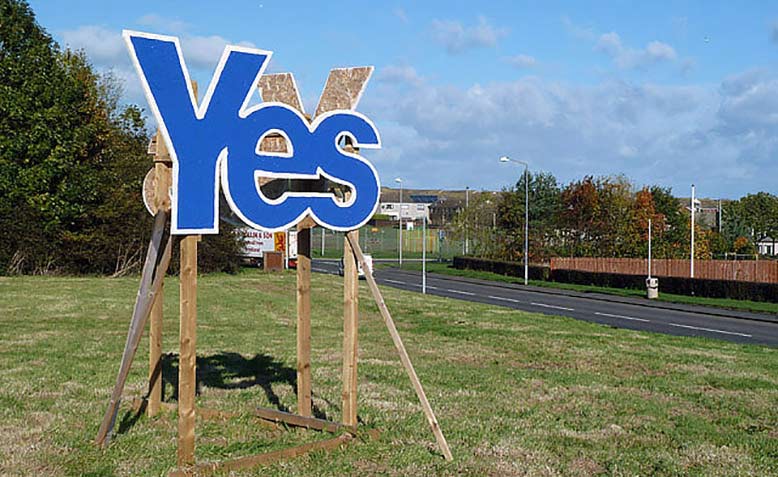 A Scottish Independence referendum campaign sign at Eyemouth. Photo: Geograph
A Scottish Independence referendum campaign sign at Eyemouth. Photo: Geograph
What now in the campaign for Scottish independence?
Scottish National Party delegates came away from their Aberdeen Spring Conference last weekend with a spring in their step. Theresa May had just handed them a gift which their leader (and Scotland’s First Minister), Nicola Sturgeon, milked for all it was worth.
The prime minister had responded to Sturgeon’s announcement that she would seek approval from the Scottish Parliament for a second independence referendum at the close of Brexit negotiations. May responded by announcing that Sturgeon could do no such thing and would have to wait until the UK had left the European Union (Westminster has the final say on staging a referendum).
From the podium, Sturgeon was quick to describe this as an affront to Scottish democracy by a politician whose party has just one MP in Scotland. To add some spice, she also invoked Margaret Thatcher’s name.
Whenever it turns out to be, it is clear we are heading towards a second Scottish independence referendum.
This flows from last June’s UK referendum on EU membership, in which Scotland voted Remain and England and Wales voted Leave. The SNP minority government immediately stated that it wanted Scotland to stay in the EU, or at least the Single Market, and that it wanted other guarantees such as protecting EU citizens living in Scotland.
May headed north to discuss these issues, but nothing substantial has been forthcoming. The SNP’s argument is that the only way to guarantee these things was via independence. May’s decision to trigger Article 50, amid signs that she is going for a ‘Hard Brexit’, prompted Sturgeon’s move to announce there would be a second referendum.
Interestingly, in Aberdeen last weekend the SNP leadership moved the issue away from Scotland’s membership of the EU. Instead it was floated that it might join the European Free Trade Association, which Norway belongs to, but not to the EU. Behind the scenes the number crunchers had worked out that many people who had voted Yes to independence in 2014 then voted Leave last year, which could influence the outcome in a finely balanced contest.
Another concern was that voters on Scotland’s housing estates, who had been won to Yes in 2014, were not going to be motivated by a pro-EU ticket. May’s announcement allowed the SNP to pivot the issue back onto Tory rule of Scotland and their lack of any democratic mandate.
During the 2014 referendum campaign a “safely as she goes” message – that nothing much would change if Scots voted for independence – was going nowhere. What made the contest that much tighter, with the British elite in panic towards the close that Yes might win, was a more radical edge injected into the campaign, particularly by the Radical Independence Campaign (RIC).
RIC supporters hit the doorsteps on the estates putting forward an argument that an independent Scotland could escape Westminster’s addiction to the free market, wars and finance, promoting welfare instead. That hit the nail on the head.
This time round the campaign has set itself the same task explaining:
“RIC will make sure this referendum offers a positive alternative where Scotland democratically decides how to share our resources and wealth. This, not the EU, is at the heart of the Radical Yes message…
“In an independent Scotland, we can defend migrant rights and confront the real social issues of inadequate housing, unemployment and low wages that drive people into the hands of the authoritarian right. But that means arguing for our vision in the here and now – not waiting until after independence. We will show that the injustice of inequality has nothing to do with immigration and everything to do with a failing system that puts the profits of the richest 1% above the needs of everyone else.”
Campaigning starts now, as does setting out a vision for an independent Scotland. Last weekend the SNP conference voted for a state investment bank, good, but it needs real clout if it is going to invest to create jobs and rebuild a viable industrial base. Scotland needs to take control of its own finances, and that means its own currency.
It also means building a close alliance with people in Catalonia as they demand an independence referendum but are blocked by May’s brother in arms, Spanish premier Rajoy.
The pro-independence campaign flows not from nationalism but a desire for genuine democracy and choice, and a horror at what successive Labour and Tory governments at Westminster have inflicted on people. Becoming independent would weaken the British state, its elite and, hopefully, act as an inspiration for ordinary folk south of the border.

